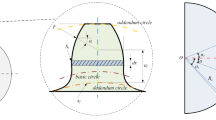Abstract
Planetary gear trains (PGTs) have been used in various applications, including hybrid and electric vehicles, owing to their advantages such as compactness, light weight, and large torque-to-weight ratio; however, recently, their transient response, such as sudden stop in differential usage when applied to cooperative robots (CRs), has emerged as a critical issue. It is difficult to elucidate the motion mechanism of PGTs, due to differing meshing conditions among internal and external meshing, the large number of meshing points, and simultaneous rotation and revolution. Therefore, few experimental investigations concerning PGT transient responses have been performed worldwide.
This study aims to elucidate the transient response, in particular in the case of reverse rotation, considering the critical issues pertaining to the use of PGTs in CRs. Transient response has three continuous phases: braking, stopping, and starting. A novel gear train, named 2K-HV PGT, having a clear acrylic carrier, was developed to enable direct observation of the planet gear motion, because it is otherwise impossible to observe the inner mechanisms of the conventional 2K-H PGT. Direct observations of the novel PGT were recorded using a high-speed camera.
The observations of the transient responses showed differences in the switching times or stopping phases, due to differences in the moments of inertia and torsional rigidities among the PGT components. The transient response of reverse rotation did not occur instantaneously, but rather gradually within a certain time band.
Zusammenfassung
Planetengetriebewerke (PGT) werden in verschiedenen Anwendungen – einschließlich Hybrid- und Elektrofahrzeugen – genutzt, da sie Vorteile wie Kompaktheit, geringes Gewicht und hohes Drehmoment-Gewicht-Verhältnis bieten; allerdings ist in letzter Zeit ihre Transient Response wie ein abruptes Ende der Nutzung von Differentialgetrieben bei Anwendung an Kollaborativen Robotern (CR) als kritisches Problem zutage getreten. Aufgrund unterschiedlicher Bedingungen des Kämmens beim internen und externen Kämmen, der großen Anzahl von Kämmpunkten und der gleichzeitigen Rotation und Umwälzung ist es schwierig, den Bewegungsmechanismus von Planetengetrieben zu erläutern. Daher wurden weltweit nur wenige experimentelle Untersuchungen hinsichtlich der PGT-Transient Response durchgeführt.
Diese Studie verfolgt das Ziel, die Transient Response, insbesondere im Falle der Rückwärts-Rotation, zu erläutern und dabei die kritischen Probleme hinsichtlich der Nutzung von PGTs in CRs zu berücksichtigen. Transient Response besteht aus drei kontinuierlichen Phasen: Bremsen, Anhalten und Starten. Um eine direkte Beobachtung der Bewegung des Planetengetriebes zu ermöglichen, wurde ein neues Räderwerk mit einem klaren Acryl-Gestell entwickelt, da es sonst nicht möglich gewesen wäre, die inneren Mechanismen des konventionellen 2K-H PGT zu beobachten. Die direkten Beobachtungen der neuen PGT wurden mit einer Hochgeschwindigkeitskamera aufgezeichnet.
Die Beobachtungen der Transient Responses haben die auf die Unterschiede der Trägheitsmomente und Verwindungssteifheiten zwischen PGT-Komponenten zurückzuführenden Unterschiede der Schaltzeiten oder Stoppphasen aufgezeigt. Die Transient Response der Rückwärts-Rotation ist nicht sofort aufgetreten, sondern eher graduell innerhalb einer bestimmten Laufzeit.

















Similar content being viewed by others
References
Ohn H, Yu S, Min K (2010) Spark timing and fuel injection strategy for combustion stability on HEV powertrain. Control Eng Pract 18(11):1272–1284
Liu J, Peng H, Filipi Z (2005) Modeling and analysis of the Toyota hybrid system. International Conference on Advanced Intelligent Mechatronics, pp 24–28
Ishibashi A, Haidar MA, Sonoda K (1997) Theoretical efficiency of planetary gear drives with two degrees-of freedom. J JSME 63(611):2518–2525 (in Japanese)
Cooley GC, Parker RG (2014) A review of planetary and epicyclic gear dynamics and vibrations research. Appl Mech Rev. https://doi.org/10.1115/1.4027812
Wu X, Parker RG (2008) Modal properties of planetary gears with an elastic continuum ring gear. J Appl Mech 75:031014–1–031014–12
Parker RG (2000) A physical explanation for the effectiveness of planet phasing to suppress planetary gear vibration. J Sound Vib 236:561–573
Aoyama E, Hirogaki T, Uenishi Y, Yamada K, Nakata Y (2000) Monitoring of rotational behavior on spiral bevel gears. J JSME 66(644):1284–1290 (in Japanese)
Arai N, Kawamoto S, Hirogaki T, Uenishi Y, Arakawa N, Toyama K (1993) Study on the speed variation of Oerlikon-type bevel gears. J JSME 59(560):1204–1209 (in Japanese)
Fukuda T, Nakagawa M, Syota M, Hirogaki T, Aoyama E (2018) Investigation of planet gear motion in a planetary gear train with direct high speed monitoring. Proceeding of the ASME IDETC/CIE 2018 (DETC2018–85505)
Nakagawa M, Nishida D, Fukuda T, Hirogaki T, Aoyama E (2018) Investigation of planet gear instant center of rotation under three-axis driving differential planetary gear train with graphical analysis using high speed camera. J JSME 84(866):1–11 (in Japanese)
Imai S, Ishida A (1990) Measurement of instant center on motion of temporomandibular, driving performance of magnetic planetary gears with dual-input and single-output functionality. J Med Electron Biol Eng 28(1):18–24 (in Japanese)
Suzuki K, Morita T (2010) From the basics of mechanism, pp 36–49 (in Japanese)
Author information
Authors and Affiliations
Corresponding author
Rights and permissions
About this article
Cite this article
Fukuda, T., Nakagawa, M., Hirogaki, T. et al. Investigation of transient response motion of differential planetary gear train during reverse rotation and starting by using high-speed camera monitoring. Forsch Ingenieurwes 83, 509–520 (2019). https://doi.org/10.1007/s10010-019-00356-3
Received:
Accepted:
Published:
Issue Date:
DOI: https://doi.org/10.1007/s10010-019-00356-3




